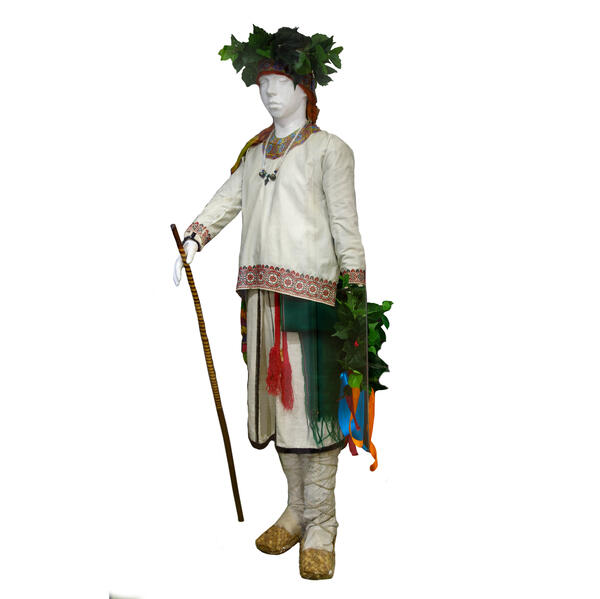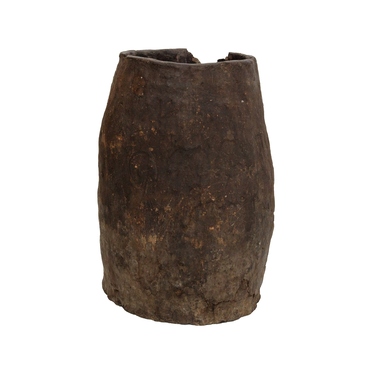The southwestern ethnic group of the Mordvin-Moksha lives in the Zubovo-Polyansky and Torbeyevsky districts of the Mordovian Republic, as well as in the Belinsky district of the Penza region.
The main occupations of the population of this territory both in the past centuries and nowadays are farming and cattle breeding, as well as beekeeping. These lands are the indigenous settlements of the Mordvin people, as evidenced by the archaeological finds of the 7 –11 centuries near the villages of Zhuravkino and Staroye Badikovo.
The exhibition presents a festive costume of a Moksha girl. The original Moksha costume can be distinguished by its opulent volume. The main element was a loose white shirt, which was worn with a large overlap that softly draped on the hips. The festive shirt of girls and young women was called “kota targaf shcham” and differed from the everyday version by richer embroidery. The whiteness of the fabric was accentuated by bright embroidery, made in contrasting colors: black, purple, green, blue and orange. The costume was completed with patterned jewelry made of colored beads, as well as silver coins and large glass beads.
An apron with sleeves called “zapon” was worn under the shirt. In the front it reached just below the waist, while the yoke (a cut-off detail on the back) reached only to the shoulder-blades. The apron was embroidered along the hem, yoke and the edge of the sleeves. Originally zapon was part of the working clothes, but soon it turned into an element of a festive costume.
In different villages of the southwestern Mordvin-Moksha group the costumes differed slightly. For example, in the northern villages of the region the shirt was worn with a large “navershnik” (a long dress with short sleeves like a tunic) on the zapon. Girls also wore peculiar headdresses made of a towel with ornate ends. Local beaded jewelry was usually of pastel colors of materials. In addition, bright green cashmere sashes (wide belts) were worn in the north.
Despite the fact that the process of the changing and developing of the folk costume as a whole stopped in the 1950s, in some regions the Moksha, especially the elderly, continue to wear traditional clothing. In particular, in the southwest of the republic. Many Moksha women still wear the snow-white traditional attire on the day of patronal festival, going to church or to the cemetery.
Local craftswomen often remake old beaded jewelery and create similar ones from new materials for their fellow villagers. The owners of vintage costumes tend to update them with simpler solutions, by adding large sequins and Christmas tinsel.
The main occupations of the population of this territory both in the past centuries and nowadays are farming and cattle breeding, as well as beekeeping. These lands are the indigenous settlements of the Mordvin people, as evidenced by the archaeological finds of the 7 –11 centuries near the villages of Zhuravkino and Staroye Badikovo.
The exhibition presents a festive costume of a Moksha girl. The original Moksha costume can be distinguished by its opulent volume. The main element was a loose white shirt, which was worn with a large overlap that softly draped on the hips. The festive shirt of girls and young women was called “kota targaf shcham” and differed from the everyday version by richer embroidery. The whiteness of the fabric was accentuated by bright embroidery, made in contrasting colors: black, purple, green, blue and orange. The costume was completed with patterned jewelry made of colored beads, as well as silver coins and large glass beads.
An apron with sleeves called “zapon” was worn under the shirt. In the front it reached just below the waist, while the yoke (a cut-off detail on the back) reached only to the shoulder-blades. The apron was embroidered along the hem, yoke and the edge of the sleeves. Originally zapon was part of the working clothes, but soon it turned into an element of a festive costume.
In different villages of the southwestern Mordvin-Moksha group the costumes differed slightly. For example, in the northern villages of the region the shirt was worn with a large “navershnik” (a long dress with short sleeves like a tunic) on the zapon. Girls also wore peculiar headdresses made of a towel with ornate ends. Local beaded jewelry was usually of pastel colors of materials. In addition, bright green cashmere sashes (wide belts) were worn in the north.
Despite the fact that the process of the changing and developing of the folk costume as a whole stopped in the 1950s, in some regions the Moksha, especially the elderly, continue to wear traditional clothing. In particular, in the southwest of the republic. Many Moksha women still wear the snow-white traditional attire on the day of patronal festival, going to church or to the cemetery.
Local craftswomen often remake old beaded jewelery and create similar ones from new materials for their fellow villagers. The owners of vintage costumes tend to update them with simpler solutions, by adding large sequins and Christmas tinsel.



